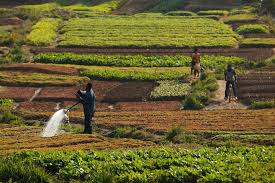Soils and Food Security
To achieve and maintain food security, policy- and decision making is required at global to local levels requiring access to quality-assessed information at the appropriate scale. As the international reference and information centre on soils, ISRIC provides such soil information and can provide support in developing dedicated soil information systems.

Today, soils globally provide ample food for 7 billion people. The availability though is unevenly distributed and 1 billion people are structurally underfed. To provide for food for 9-10 billion people by 2050, the biophysical as well as the socio-economic availability of food as well as of the food productive capacity are to be strongly improved. Crucial is the capacity of land users worldwide to manage their soils sustainably and productively.
Judicious soil management plays an important role in realising UN Sustainability Goal (SDG) 2, which aims to end hunger, achieve food security and improved nutrition, and promote sustainable agriculture. This this is particularly reflected in action point 2.4: 'by 2030 ensure sustainable food production systems and implement resilient agricultural practices that increase productivity and production, and that progressively improve land and soil quality.' In other words, achieving food security is a challenge and maintaining it another one, and soils are an important part of the solution.
Soils are at the very base of our food production and we, humans, are at the very base of our soils. Soils need maintenance, but exploitation of soils has only intensified due to increasing pressure. In 2014, arable land per person was 0.20 ha while 50 years ago this was some 0.37 ha, with marked regional differences as reported by the World Bank. This alarming trend cries for important investments necessary to restore, maintain and progressively improve the productive capacity of each ha of farmed soil.
Investments cannot be made if not supported by adequate information at the appropriate scale and significance. ISRIC creates and maintains soil information in support of policy- and decision making. Our databases can be integrated with agricultural models (e.g. crop, water, and fertility) to explore scenarios that can be used to give advice from the global to the local scale, where the actual difference can be made. Ultimately, world soil information contributes significantly to achieving and maintaining food security if locally accurate and relevant, and globally consistent and complete.
Interested? Please contact us on how we can collaborate towards food security!
Links:
- Global Soil Partnership (GSP)
- Research programme on Climate Change, Agriculture and Food Security (CGIAR-CCAFS)
- UN Sustainable Development Goals (UN-SDG)
- Global Yield Gap Atlas (GYGA)
- Enhancing rice markets in Uganda through smart micronutrient fertilization (ENRICH)
- Impact of desertification on food security in southern Africa: a case study for Zimbabwe (ZILRIS)
- Soil and Food Security (Theme Station #1, ISRIC World Soil Museum)